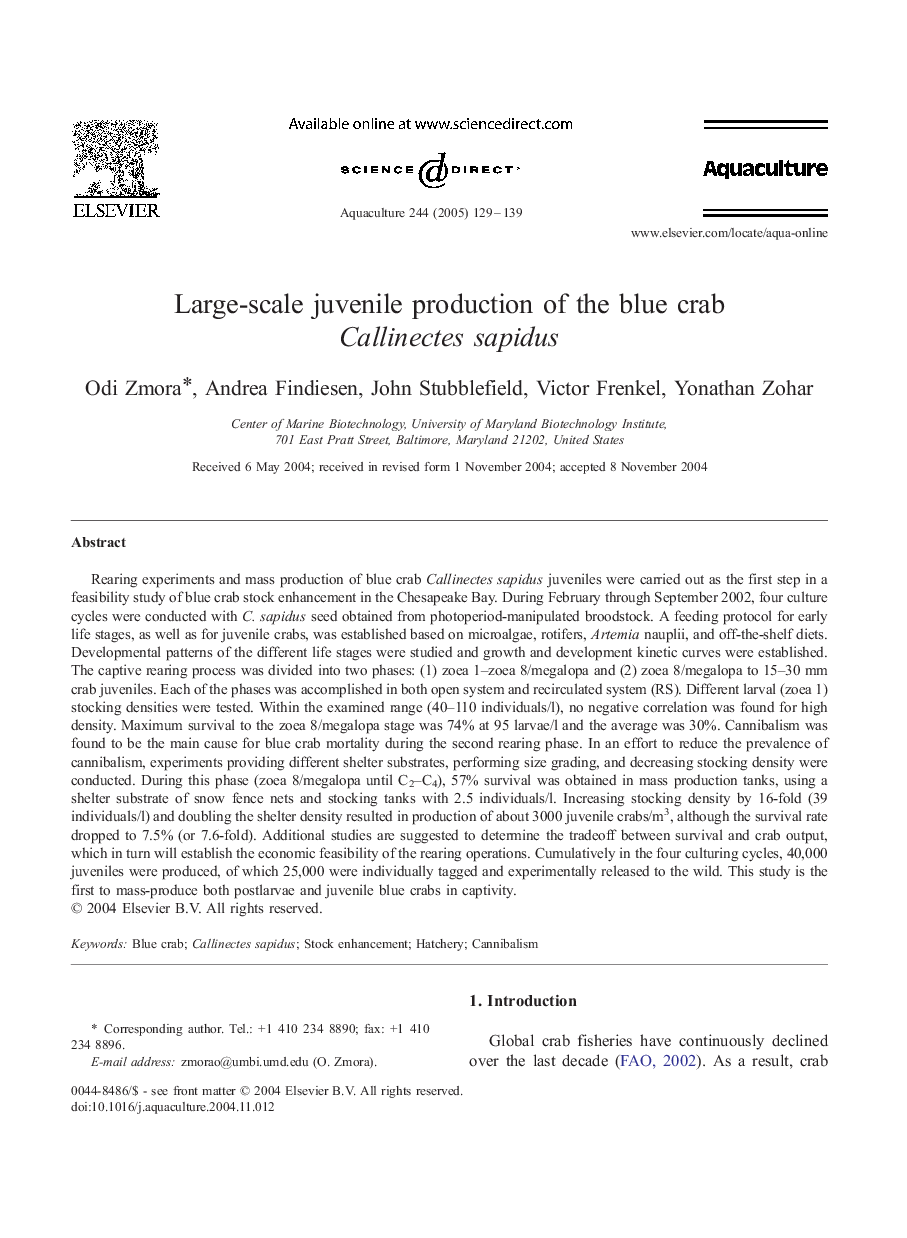| کد مقاله | کد نشریه | سال انتشار | مقاله انگلیسی | نسخه تمام متن |
|---|---|---|---|---|
| 8974906 | 1552998 | 2005 | 11 صفحه PDF | دانلود رایگان |
عنوان انگلیسی مقاله ISI
Large-scale juvenile production of the blue crab Callinectes sapidus
دانلود مقاله + سفارش ترجمه
دانلود مقاله ISI انگلیسی
رایگان برای ایرانیان
کلمات کلیدی
موضوعات مرتبط
علوم زیستی و بیوفناوری
علوم کشاورزی و بیولوژیک
علوم آبزیان
پیش نمایش صفحه اول مقاله

چکیده انگلیسی
Rearing experiments and mass production of blue crab Callinectes sapidus juveniles were carried out as the first step in a feasibility study of blue crab stock enhancement in the Chesapeake Bay. During February through September 2002, four culture cycles were conducted with C. sapidus seed obtained from photoperiod-manipulated broodstock. A feeding protocol for early life stages, as well as for juvenile crabs, was established based on microalgae, rotifers, Artemia nauplii, and off-the-shelf diets. Developmental patterns of the different life stages were studied and growth and development kinetic curves were established. The captive rearing process was divided into two phases: (1) zoea 1-zoea 8/megalopa and (2) zoea 8/megalopa to 15-30 mm crab juveniles. Each of the phases was accomplished in both open system and recirculated system (RS). Different larval (zoea 1) stocking densities were tested. Within the examined range (40-110 individuals/l), no negative correlation was found for high density. Maximum survival to the zoea 8/megalopa stage was 74% at 95 larvae/l and the average was 30%. Cannibalism was found to be the main cause for blue crab mortality during the second rearing phase. In an effort to reduce the prevalence of cannibalism, experiments providing different shelter substrates, performing size grading, and decreasing stocking density were conducted. During this phase (zoea 8/megalopa until C2-C4), 57% survival was obtained in mass production tanks, using a shelter substrate of snow fence nets and stocking tanks with 2.5 individuals/l. Increasing stocking density by 16-fold (39 individuals/l) and doubling the shelter density resulted in production of about 3000 juvenile crabs/m3, although the survival rate dropped to 7.5% (or 7.6-fold). Additional studies are suggested to determine the tradeoff between survival and crab output, which in turn will establish the economic feasibility of the rearing operations. Cumulatively in the four culturing cycles, 40,000 juveniles were produced, of which 25,000 were individually tagged and experimentally released to the wild. This study is the first to mass-produce both postlarvae and juvenile blue crabs in captivity.
ناشر
Database: Elsevier - ScienceDirect (ساینس دایرکت)
Journal: Aquaculture - Volume 244, Issues 1â4, 28 February 2005, Pages 129-139
Journal: Aquaculture - Volume 244, Issues 1â4, 28 February 2005, Pages 129-139
نویسندگان
Odi Zmora, Andrea Findiesen, John Stubblefield, Victor Frenkel, Yonathan Zohar,